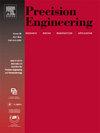中等变形范围柔性机构的动态Timoshenko梁约束模型
IF 3.5
2区 工程技术
Q2 ENGINEERING, MANUFACTURING
Precision Engineering-Journal of the International Societies for Precision Engineering and Nanotechnology
Pub Date : 2025-03-23
DOI:10.1016/j.precisioneng.2025.03.023
引用次数: 0
摘要
处于中等变形范围的柔性机构可以在许多应用中找到,包括大行程精密定位平台,机器人枢轴,能量采集器和微机电系统等。然而,几何非线性往往导致巨大的设计挑战。本文建立了一种动态Timoshenko梁约束模型(DTBCM),用于描述受大振幅振动的弯曲梁的非线性力-位移关系,包括剪切变形和旋转惯性的影响。在轴向力和节点位移作用下,分别推导了两节点弯曲梁的等效动力刚度矩阵。采用全矩阵运算,所提出的DTBCM能够简化建模过程,从而为复杂串并联结构的非线性动静态和动态分析提供了一个简单的工具。通过两个算例讨论了剪切变形和转动惯量对非线性刚度的影响,特别是对振幅相关共振频率的影响。在两种情况下,分别观察到动力加筋和弱刚度软化的几何非线性。本文章由计算机程序翻译,如有差异,请以英文原文为准。
A dynamic Timoshenko beam constraint model for use in compliant mechanisms with intermediate deformation ranges
Compliant mechanisms undergoing intermediate deformation ranges can be found in many applications, including large-stroke precision positioning stages, robotic pivots, energy harvesters and micro-electro-mechanical systems, etc. However, the geometric nonlinearity often leads to great design challenges. A dynamic Timoshenko beam constraint model (DTBCM) is herein reported to capture the nonlinear force-displacement relationship of flexure beams undergoing large-amplitude vibrations, including the effects of shear deformation and rotary inertia. Two equivalent dynamic stiffness matrices of the DTBCM are also derived for two-node flexure beams in the presence of axial forces and nodal displacements, respectively. With a full matrix operation, the presented DTBCM enables a concise modeling process, and hence offers a straightforward tool for nonlinear kinetostatic and dynamic analyses of complex serial-parallel configurations. The influence of shear deformation and rotary inertia on the nonlinear stiffness and particularly on the amplitude-dependent resonance frequency is discussed through two case studies. The geometric nonlinearities of dynamic stiffening and weak stiffness softening are, respectively, observed with the two case studies.
求助全文
通过发布文献求助,成功后即可免费获取论文全文。
去求助
来源期刊
CiteScore
7.40
自引率
5.60%
发文量
177
审稿时长
46 days
期刊介绍:
Precision Engineering - Journal of the International Societies for Precision Engineering and Nanotechnology is devoted to the multidisciplinary study and practice of high accuracy engineering, metrology, and manufacturing. The journal takes an integrated approach to all subjects related to research, design, manufacture, performance validation, and application of high precision machines, instruments, and components, including fundamental and applied research and development in manufacturing processes, fabrication technology, and advanced measurement science. The scope includes precision-engineered systems and supporting metrology over the full range of length scales, from atom-based nanotechnology and advanced lithographic technology to large-scale systems, including optical and radio telescopes and macrometrology.

 求助内容:
求助内容: 应助结果提醒方式:
应助结果提醒方式:


